Phenotypes - Study guides, Revision notes & Summaries
Looking for the best study guides, study notes and summaries about Phenotypes? On this page you'll find 1489 study documents about Phenotypes.
Page 3 out of 1.489 results
Sort by
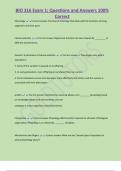
-
BIO 316 Exam 1; Questions and Answers 100% Correct
- Exam (elaborations) • 26 pages • 2024
- Available in package deal
-
- £12.24
- + learn more
BIO 316 Exam 1; Questions and Answers 100% Correct Physiology Correct answer-The branch of biology that deals with the functions of living organisms and their parts natural selection Correct answer-Organismal function has been shaped by _________ in different environments. Darwin's 4 postulates of natural selection Correct answer-1. Phenotypes vary within populations 2. Some of this variation is passed on to offspring 3. In every generation, more offspring are produced than can sur...
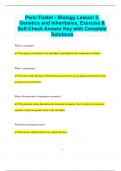
-
Penn Foster - Biology Lesson 3, Genetics and Inheritance, Exercise & Self-Check Answer Key with Complete Solutions
- Exam (elaborations) • 82 pages • 2024
- Available in package deal
-
- £9.79
- + learn more
Penn Foster - Biology Lesson 3, Genetics and Inheritance, Exercise & Self-Check Answer Key with Complete Solutions What is a genotype? The genetic constitution of an individual, represented by the combination of alleles. What is a phenotype? The observable physical or biochemical characteristics of an organism determined by the genotype and environment. What is the principle of segregation in genetics? The principle stating that during the formation of gametes, the two allel...
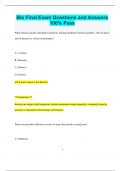
-
Bio Final Exam Questions and Answers 100% Pass
- Exam (elaborations) • 22 pages • 2024
-
- £8.15
- + learn more
Bio Final Exam Questions and Answers 100% Pass What domain includes unicellular organisms lacking membrane-bound organelles, often living in and on humans in various relationships? A.) Archaea B.) Bacteria C.) Eukarya D.) Protista Correct Answer: B.) Bacteria **Explanation:** Bacteria are single-celled organisms without membrane-bound organelles, commonly found in parasitic or mutualistic relationships with humans. What term describes different versions of genes that encod...
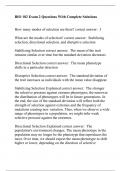
-
BIO 182 Exam 2 Questions With Complete Solutions
- Exam (elaborations) • 27 pages • 2023
- Available in package deal
-
- £10.60
- + learn more
How many modes of selection are there? correct answer: 3 What are the modes of selection? correct answer: Stabilizing selection, directional selection, and disruptive selection Stabilizing Selection correct answer: The mean of the trait remains similar over time but the standard deviation decreases Directional Selection correct answer: The mean phenotype shifts in a particular direction Disruptive Selection correct answer: The standard deviation of the trait increases as individ...

-
SBB Genetic, Rh and RBC Membrane Exam 2024 Update
- Exam (elaborations) • 13 pages • 2024
-
- £14.69
- + learn more
SBB Genetic, Rh and RBC Membrane Exam 2024 Update The 1980s - ANSWER-What decade was the start of Rh molecular biology and purification of Rh D polypeptides The 1990s - ANSWER-What decade started the cloning of Rh genes and molecular bases of D+ and D -phenotypes

-
PCOL 838 Final Exam
- Other • 38 pages • 2024
- Available in package deal
-
- £11.42
- + learn more
acrocentric Refers to the terminal location of the centromere on chromosomes 13, 14, 15, 21 and 22 allelic heterogeneity the situation in which multiple alleles at a singe locus can produce one or more disease phenotypes amorphic Refers to mutations that cause a complete loss of function for the respective gene, and therefore yield the same phenotype as a complete gene deletion Aneuploidy denotes any unbalanced chromosome complement antimorphic Refers to mutations that when present in h...
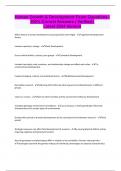
-
Human Growth & Development Exam Questions | 100% Correct Answers | Verified | Latest 2024 Version
- Exam (elaborations) • 14 pages • 2024
-
- £10.20
- + learn more
Which theory of human development was proposed by Jean Piaget - Cognitive Developmental theory Involves capacity to change - Plastic Development Occurs within families, schools, peer groups - Contextual Development Includes how body, mind, emotions, and relationships change and affect each other - Coconstructional Development Involves biological, cultural, and individual factors - Multidimensional Development Descriptive research - Gathering information by observing and recording behavior ...

-
WGU C652 Final Exam (Latest 2024/ 2025 Update) Genetics and Heredity| Prep Questions and Verified Answers| 100% Correct| Grade A
- Exam (elaborations) • 43 pages • 2024
- Available in package deal
-
- £9.38
- + learn more
WGU C652 Final Exam (Latest 2024/ 2025 Update) Genetics and Heredity| Prep Questions and Verified Answers| 100% Correct| Grade A Q: Which of the following is true of a species that has a chromosome number of 2n = 16? Answer: There are 8 homologous pairs. Q: After telophase I of meiosis, the chromosomal makeup of each daughter cell is Answer: Haploid, and the chromosomes are composed of two chromatids. Q: During which of the following stages of meiosis do tetrads of c...
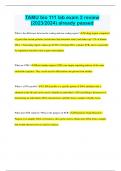
-
TAMU bio 111 lab exam 2 review (2023/2024) already passed
- Exam (elaborations) • 14 pages • 2023
- Available in package deal
-
- £8.15
- 2x sold
- + learn more
TAMU bio 111 lab exam 2 review (2023/2024) already passed What is the difference between the coding and non-coding region? Coding region: comprised of genes that encode proteins (instructions that determine traits) and makes up 1-2% of human DNA. • Noncoding region: makes up 98-99% of human DNA, contains STRs and is responsible for regulatory functions such as gene transcription. What are STRs? Short-tandem repeats (STRs) are unique repeating patterns of the same nucleotide sequence. They can...
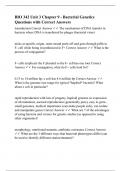
-
BIO 342 Unit 3 Chapter 9 - Bacterial Genetics Questions with Correct Answers
- Exam (elaborations) • 17 pages • 2024
-
- £12.24
- + learn more
transduction Correct Answer The mechanism of DNA transfer in bacteria where DNA is transferred by phages (bacterial virus) nicks at specific origin, outer strand peels off and goes through pillis to F- cell while being resynthesized in F+ Correct Answer What is the process of conjugation? F- cells (replicate the F plasmid so the F- cell has one too) Correct Answer For conjugation, what do F+ cells look for? 0.13 to 14 million bp, e coli has 4.6 million bp Correct Answer What is the ...

Do you wonder why so many students wear nice clothes, have money to spare and enjoy tons of free time? Well, they sell on Stuvia! Imagine your study notes being downloaded a dozen times for £15 each. Every. Single. Day. Discover all about earning on Stuvia


